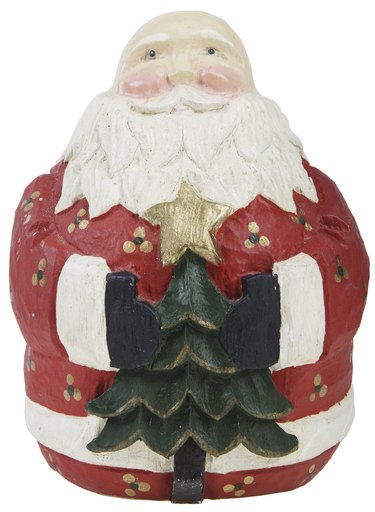
If an individual goes looking for resin figurines, they are likely to at least be partly knowledgeable about the different kinds that are available. The kind of figurines individuals like to display depends on personal preference. Porcelain figurines look more attractive and elegant to most individuals. Individuals who have a preference for older-looking, hand-made decorations favor ceramic figurines.
Ceramics
Video of the Day
Simple ceramics are typically created with a mixture of clay, water and sand. The mixture hardens by either drying naturally in the desired figurine shape or, as is more commonly used, heated until completely solid. As unprotected ceramics absorb water easily, the finished figurines are often coated in a protective glaze, such as varnish and several coats of paint. Ceramics is different to procelain in this case, as porcelain doesn't need a protective coating. The paint is also used for creating different color patterns on the figurine, not just for the protection of the finished item.
Video of the Day
Properties of Ceramic Figurines
Due to the initial stage of ceramic creation, resin figurines are easier to make. The shape of the figurine is first formed from a liquid material, so designing the desired shape is simple to achieve. Also, once a ceramic item has been glazed, it becomes quite sturdy against moderate impacts. Ceramic resin figurines are also quite easy to clean, difficult to burn and resistant to scratches. Ceramic resin figurines tend to be cheaper than porcelain figurines due to the relative ease of creating them. However, ceramic figurines aren't as tough as porcelain.
Porcelain
Porcelain is also known as china and chinaware as homage to the recognized birthplace of porcelain. Porcelain figurines are characterized by a pale white finish and smooth outer texture. Porcelain is commonly made from a mixture of two key ingredients: kaolin, which is white clay derived from the material feldspar, and petuntse, a powder-like material found only in China. The heat needed in order to make porcelain melt has to be between 1250 to 1450 degrees Celsius.
Properties of Porcelain Figurines
Porcelain is much harder to shape than ceramic; this is due to the higher level of heat needed to make porcelain melt. Professional tools are needed and once a figurine is made, it is difficult to change. However, porcelain resin figurines don't have to be glazed like ceramic figurines due to its glass-like characteristics. This gives porcelain figurines greater initial protection than ceramic figurines. The different colors and patterns on porcelain figurines are a result of professional painting; this makes porcelain figurines more beautiful than painted ceramics and more desired by individuals as decorations.